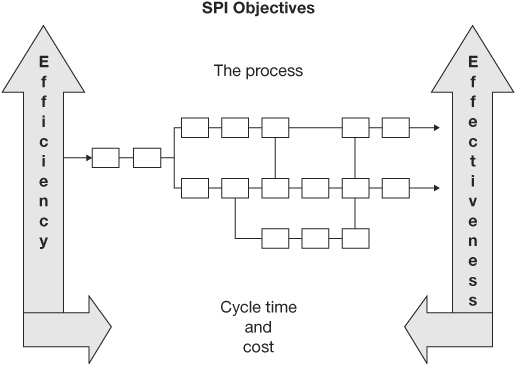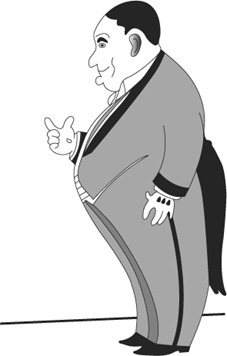CHAPTER
1
Introduction to Streamlined Process Improvement (SPI)
Business Process Improvement (methodology) investigated and established by Dr. H. James Harrington and his group [represents] some of the new strategies which bring revolutionary improvement not only in [the] quality of products and services, but also [in] the business processes which yield the excellent quality of the output.
—Professor Yoshio Kondo,
the leading Japanese quality authority
Introduction
We have more opportunities to improve our processes than we have problems to solve.
—H. James Harrington
This book is designed to help you streamline your processes, making them more efficient and effective. This will allow you to sell your products and services at a lower price and still make more profit than your competitors. In car design, streamlining reduces an auto’s air resistance, making it operate more effectively and making it more attractive to customers. On the other hand, a lean car has only the essentials.
When you streamline your processes, they operate at lower cost and cycle time and at increased efficiency and effectiveness. (See Figure 1.1.) In addition, the resulting changes are implemented with much less resistance and greater acceptance by the management team and the employees than processes redesigned using reengineering, DMADV, or Design for Six Sigma methodologies.
Today we hear a lot about Lean Six Sigma—it is the removal of all waste from the organization. Currently, most organizations could be represented by the overweight person in Figure 1.2.
Our processes are full of bureaucracy and waste. As we run into a problem, we just add more and more bureaucracy so that the problem will not reoccur. This just wastes time and money. A Lean Six Sigma organization could be represented by the person in Figure 1.3.
As you can see, the person in the figure is very lean; all fat has been removed. People who are that thin have often gone to extremes to lose the fat and keep it off, but in doing so, they have thrown their body’s meaningful checks and balances out of kilter. They have often lost their natural protection from disease (problems) and are susceptible to any and all of the diseases that come along. Toyota got into its quality and recall problems because it got too lean. The streamlined organization can be represented by the figure in Figure 1.4.

Figure 1.1 Impact of SPI activities on processes

Figure 1.3 An extremely skinny person
With streamlining you may start out as the person depicted in Figure 1.2, but after beginning an exercise program, you lose (remove) the waste and transform fat into muscle. You feel better, are healthier, and are more creative. You streamlined not only the processes, but also the way you think and go about doing business.
Streamlining Fundamentals
The following are the key fundamentals that must be considered when you undertake to streamline a process:
1. The process to be streamlined should be chosen based on how valuable it is to the organization, how badly the process is broken, and what the impact upon the organization would be if the process were improved.
2. It is a mistake to try to improve too many processes at the same time. Do only three or four at a time.
3. A good database that measures performance of the current process should be in place before you make changes to the process. This is necessary so that you will be able to accurately measure the impact that the future-state solution has on the organization.
4. The way to begin is to ask the question, Is the process essential to the organization?
5. Simplification is better than computerization.
6. The real value of a process is how well it interacts with the other processes.
7. The best-designed process is worthless if it is not accepted by the people who will be using it.
8. Excellent communication and trust are key elements in making the streamlined process methodology a success.
9. The executive team needs to understand and fully support the SPI methodology and the output from the Process Improvement Team (PIT).
10. The external customer is the one who defines what the output from the process needs to be.
11. The combination of the process and the internal customer requirements must provide the organization with the best overall value. Internal customers’ desires may not be honored unless they add value to the organization.
12. The white-collar processes have potential for quantum improvement.
13. The processes that service the external customers should be optimized, and the others should be designed to support them.
14. The total process key measurements need to be improved, not the measurements that are related to subprocesses within the major process.
15. The key process improvement indicators are increased external customer satisfaction, reduced output costs, reduced cycle time, and increased employee morale.
16. The people who will be key players in using the process should be included in the SPI projects.
17. The risks have to be understood before any changes are made to the process.
18. Streamlining requires resources; it can’t be accomplished without a budget and people assigned to it. The employees assigned to the PIT should have their workload in other areas reduced by 20 to 40 percent.
19. The variation in the cycle time and output quality should be minimized.
Technology Warning
All too often, organizations jump to automate their processes without evaluating how effective the processes can function without being automated. This is usually a major error, as technology should serve the processes, not the other way around. Frequently, technology will speed up your processes so that you are able to make more errors faster than ever before. In other words, if the process is bad, automating it just causes an automated mess. Since technology is an enabler, rather than a process driver, it should only be applied after the process is streamlined. Far too often we automate a process or use technology to expedite the process when we should be simplifying the process. Carla Paonessa, a partner at Arthur Andersen Consulting, stated: “Just automating something that should not have been done manually won’t get you to be more productive. What will work is eliminating bottlenecks, reducing mistakes, focusing on customer service, and then and only then, introducing new technologies” (Henkoff, 1991).
Employment Security
Employment security is one of the most critical and complex political and economic issues facing top management as a result of implementing SPI. An SPI project very often will reduce the workforce requirements by 30 to 60 percent. We have seen it reduce the number of people required to operate the process by as much as 80 percent. Not addressing this condition up front often results in the failure of an SPI project. Employees often look at a process improvement project as a way to reduce the number of employees. How can you expect your employees to give freely of their ideas to increase your productivity and minimize waste if it means that their job or a friend’s job will be eliminated? If you start a continuous improvement process and then have layoffs, what you are going to end up with is employees who are continuously trying to sabotage your improvement process.
Corporate America has been on a downsizing kick since the late 1980s; its answer to business pressure is to slim down and lay off with the hope of raising stock prices, but that does not work. Three years after the downsizing, these organizations’ stock values are negative on an average of 25 percent. Figure 1.5 shows stock prices going up right after the downsizing because short-term profits were driven by the efforts expended before the downsizing. But soon the reduced resources and the loss of employee trust begin to be reflected in the organization’s performance, and stock prices drop below the level before the downsizing. This stimulates another downsizing cycle.
Figure 1.5 How the average stock price reacts to change
SPI, on the other hand, attacks the same problem, the reduction of overhead costs, but does it without decreasing the ability of the organization to meet its external customer expectations. SPI allows the organization to “right-size” its processes, removing activities that are no-value-added from the external customer’s standpoint. For example, Xerox was able to reduce its operating costs by $40 million per year by redesigning a few business processes. That’s the equivalent of laying off over 1,000 employees.
We had done downsizing and old fashioned budget cutting, but we have never changed our business environment from the bottom up.
—Harry Beeth, Assistant Controller, IBM
Corporate Headquarters (CFO, 1996)
Large layoffs produce sudden, substantial stock gains. These gains occur because the impact of the removed employees has not reached the customer and their compensation has been removed from the bottom line, making the organization appear to be more profitable than it really is. But in the long run, the downsizing has a negative impact. CEO Frank Poppoff of Dow Chemical put it this way, “Layoffs are horribly expensive and destructive of shareholder value.”
The cost to lay off and replace is growing all the time. Dow Chemical estimates that it costs between $30,000 to $100,000 for technical and managerial-type personnel. Not only do layoffs cost the organization money and some of its best people, but when it comes time to hire, the best people do not trust the organization and will not come to work for it.
An alternative approach of a golden parachute or early retirement is equally bad. The people who leave are all the best performers who will not have a problem finding new jobs. The deadwood, who barely meet minimum performance, stay because they know it will be hard to find an equally good job in today’s job market.
Employees can understand that the organization needs to cut back when demand for the product falls off, and they can accept that. The problem we face is what happens to the employees whose jobs have been eliminated due to performance improvement initiatives. We know that programs like SPI are designed to improve productivity, but if our share of the market does not keep pace with our productivity improvement, what will management do with the surplus employees? To cover this scenario and to alleviate employees’ fears, top management should release a “no-layoff policy.” A typical no-layoff policy would state: “No employee will be laid off because of improvements made as a result of the performance improvement initiative. People whose jobs are eliminated will be retrained for an equivalent or more responsible job.” You will note that the policy does not guarantee that employees will not be laid off as a result of a downturn in your business. It only protects employees from being laid off as a result of the improvement process. These are people who would still be working if SPI had not been implemented.
Federal Express Corporation has a no-layoff philosophy. Its “guaranteed fair treatment procedure” for handling employee grievances is a model for firms around the world.
I know of one organization that was able to eliminate 200 jobs as a result of a performance improvement process. As the company started the improvement process, it put a freeze on new hires and used temporary employees to cover the workload peaks. This step was reviewed with the labor union leaders, and they concurred with the use of the temporary employees to protect regular employees’ jobs. As a result, attrition took care of about 150 surplus jobs. The organization held a contest to select 50 employees who were sent to a local university to work toward an engineering degree. While at school, they received full pay, and their additional expenses were paid for by the organization. Results were phenomenal. All the employees within the organization started to look for ways to eliminate their jobs so they could go to school.
Organizations that believe that if it isn’t broke don’t fix it are slaves to the status quo.



